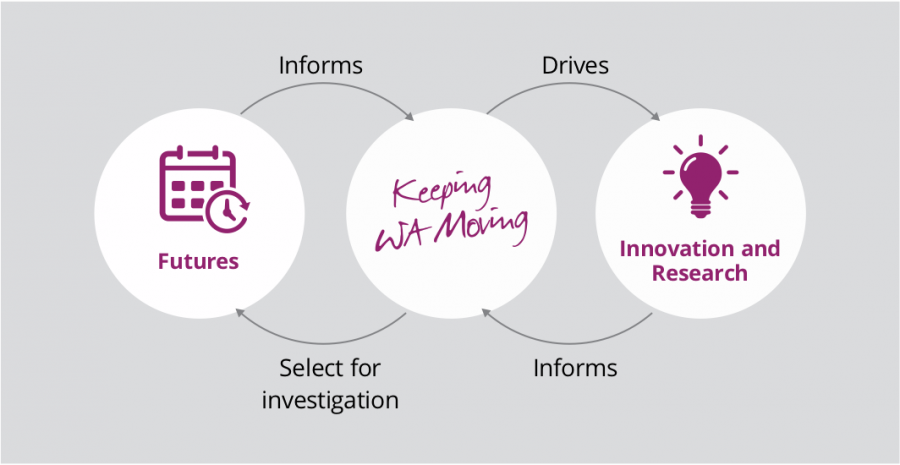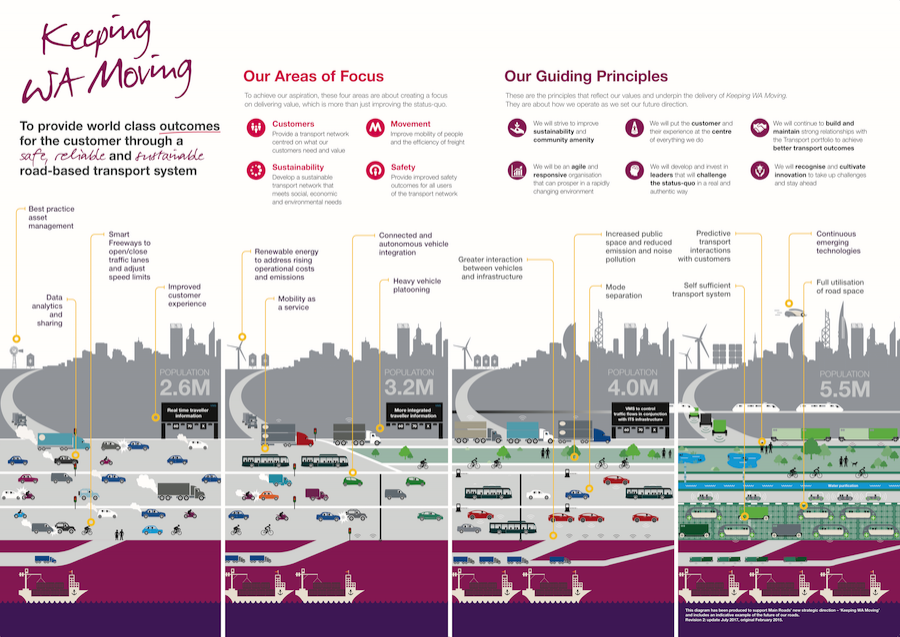Linking Strategy, Futures, Innovation and Research
Download this section (2.8 MB)Keeping WA Moving, our strategic direction, clearly outlines our areas of focus as Customers, Movement, Sustainability and Safety. These areas underpin what we do and help us concentrate on delivering what’s important.
The transportation of people and goods is one of the most important components of our everyday lives. The arrival of the fourth Industrial Revolution and the rapid development of multiple disruptive and innovative technologies is challenging the status quo. Technologies such as:
- artificial intelligence, big data and digitization
- the Internet of Things
- fifth, and even sixth, generation wireless
- technologies (5G/6G)
- connected and autonomous vehicle technologies
- on-demand ride-sharing services and Mobility as a
- Service
- 3D printing
- the sharing economy
These technologies and others are changing not only behaviour but also the expectations of the community. The fusion of these is bringing a technological revolution that will fundamentally alter the way we live, work, and relate to one another and as a road agency we need to be prepared.
To that end, we scan the external environment to prepare ourselves for the future. Over the past decade, the future of transport has been re- imagined. McKinsey recently reported US$220 billion of investments in new mobility technologies since 2010. Much of this investment has come from technology companies and start-ups – new players in the transport sector.
The transport industry expects significant disruption in coming years, given the level of investment and potential new technologies. We will need to adapt to take advantage of opportunities and minimise risks. With many potential futures for transport, we use our understanding to inform our strategy, innovation and research activities.

We represent Keeping WA Moving visually, to remind ourselves that the future will look different from today.

The point isn't to accurately predict the future, the diagram won’t be realised exactly. However, by thinking about a longer-term future, it can help us lift ourselves away from immediate challenges and re-focus on what’s important. The same applies for our future story, it’s one vision of the future to start a conversation.
Exploring Transport’s Immediate Future
It’s five years from now and you’ve bought a new car – your first fully electric car. You’ve taken the plunge because electric vehicle range has increased and the price has come down, making it competitive with petrol, diesel and hybrid vehicles. With a new fast-charging network being rolled out around Western Australia you can travel long distances around the state. And using this new fast-charging means adding hundreds of kilometres of range in the time it takes to stretch your legs, grab a coffee and take the kids to the toilet! The vehicle also has some of the new self-driving features but even when you choose to drive yourself, the vehicle helps to keep you safe.
Comparing it to your old car, you love the convenience of recharging at home. This saves you the regular trip to the petrol station and the hassle of working out which will be the cheapest day to fill-up. You save money, too, by simply plugging the charger in and opting to recharge when the cheaper off-peak rate starts or when your solar panels are generating electricity. Saving money on refuelling and maintenance is great. And you also love the fact that your car takes less time to service, the service intervals are further apart and there is less maintenance done.
Security features of new cars are amazing too! Recently someone backed into your car at a car park and drove off without leaving a note, but the cameras on your car recorded the crash so you could avoid the excess on your insurance claim.
You keep hearing stories about your friends using the new driverless taxi services to get around town. They’re even talking about not replacing their car when the time comes. You need a sizeable car, for example, to tow the caravan on the annual trip to Kalbarri. But maybe it’s time to think about getting rid of the second car, used mostly for commuting and short, around town trips?
These potential futures have current relevance for us. Generally, technologies fit one of three levels or areas, described below.
Technology for Watching
These technologies are in early development, so we watch their progress with interest for possible application. One example is the use of 3D printing technologies to create bridges. The projects deployed to date have been innovative and experimental, but it’s not too hard to envisage a future where 3D printing becomes commercial. The technology offers the potential to build structures that cannot be created in any other way, while minimising material use and the need for staging areas for large sections of bridge. We will continue to watch and look for the right time to adopt as a tool.
Technology for Preparing
Other technologies are nearing commercialisation, so we need to initiate new areas of work to prepare for and be a catalyst for the future. Although uptake is slow, we need to think about a future in which electric vehicle (EV) sales are much larger. Global sales of EVs are growing exponentially, although from a small market share. We are participating in a state working group to support collaboration on EVs. We also completed a research project with the University of Western Australia and other stakeholders to take a coordinated and strategic approach to planning for charging infrastructure for EVs.
Driverless vehicles continue to be an area for government to prepare. Identifying a time for deployment is difficult, Cruise Automation, owned by General Motors and Honda, recently announced an indefinite delay on their plans to deploy a fleet of driverless taxis in San Francisco, while Tesla CEO, Elon Musk, claims that they will be ‘feature complete on full self-driving this year’.
While there are indicators that driverless vehicles may be delayed, we still need to understand how they could impact the transport network. We continue to work with the Planning and Transport Research Centre and iMove CRC on a research project to understand the impacts of driverless vehicles on our road network. We also contribute to federal and state government initiatives by being a member or working on:
- Austroads’ Connected and Automated Vehicles Steering Committee
- National Transport Committee Automated Vehicle Regulatory Advisory Group
- Australian Driverless Vehicle Initiative Scientific and Research Group
- WA Connected and Automated Vehicle Advisory Committee
Technology for Investigating or Deploying
We use our innovation and research activities to investigate opportunities new to Main Roads. During the year, we initiated a new project to investigate whether gravel from unknown sources can be treated to ensure that it does not contain dieback. If successful, this will improve environmental and economic outcomes by allowing us to use gravel local to a project area, while preventing the further spread of dieback.

